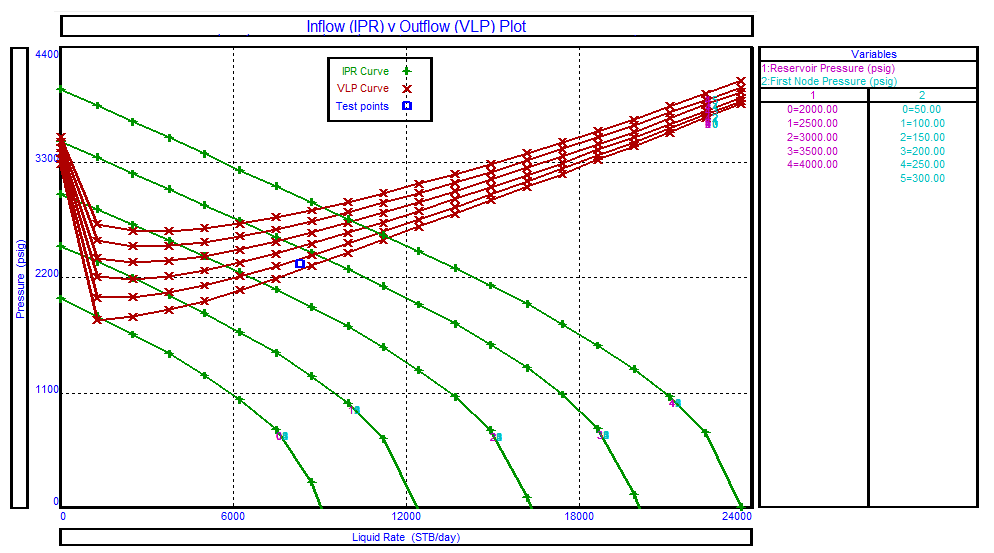Definition
WFP – Well Performance Analysis analysis is a comparative analysis between:
- the formation fluid deliverability (the ability of reservoir to produce or take-in the fluid) which is called IPR
and
- wellbore fluid deliverability (the ability of well to lift up or lift down the fluid) and which is called OPR or TPR or VFP (equally popular throughout the literature)
It is based on correlation between surface flowrate q and bottomhole pressure p_{wf} as a function of tubing-head pressure p_s and formation pressure p_R and current reservoir saturation.
Ideally, the well flow model for WFP – Well Flow Performance analysis should be performed individually for each well but even typical for a given asset can.
Application
- Setting up the required production or injection regime for each well upon the current formation pressure, reservoir saturation and production target specified by FDP
- Generating WFP – Well Flow Performance tables as input for 3D simulations
Technology
Most reservoir engineers exploit material balance thinking which is based on long-term well-by-well surface flowrate targets (whether producers or injectors).
In practice, the flowrate targets are closely related to bottomhole pressure and associated limitations and require a specialised analysis to set up the optimal lifting (completion, pump, chocke) parameters.
This is primary domain of WFP – Well Flow Performance analysis.
WFP – Well Flow Performance is performed on stabilised wellbore and reservoir flow and does not cover transient behavior which is one of the primary subjects of Well Testing domain.
The conventional WFP – Well Performance Analysis is perfomed as the
\{ p_{wf} \ {\rm vs} \ q \} cross-plot with two model curves:
- Inflow Performance Relation (IPR) – responsible for reservoir deliverability (see below)
- OPR – Outflow Performance Relation ( also called TPR – Tubing Performance Relation and VFP – Vertical Lift Performance ) – responsible for well deliverability (see below )
The intersection of IPR and OPR curves represent the stabilized flow (see Fig. 1)
| Fig. 1. The stablised flow rate is represnted as junction point of WFP – Well Flow Performance and OPR curves. | Fig. 2. The dead well scenario. |
Given a tubing head pressure p_s the WFP Junction Point will be dynamic in time depending on current formation pressure (see Fig. 2) and formation saturation (see Fig. 3).
| Fig. 2. A sample case of stablised flow rate as function of formation pressure. | Fig. 3. A sample case of stablised flow rate as function of formation water saturation and corresponding production water-cut. |
| Fig. 4. A bunch of IPRs at different formation pressures and TPRs at different THPs. |
Workflow
- Check the current production rate against the production target from FDP
- If the diffference is big enough to justify the cost of production optimization (see point 8 below) then proceed to the step 3 below
- Assess formation pressure based on well tests
- Simulate IPR/OPR based on the current WOR/GOR
- Calculate the stabilized flow bottom-hole pressure
- Gather the current bottom-hole pressure
p_{wf}
- Check up the calculation aganst the actual
p_{wf}
- Recommend the production optimisation activities to adjust bottom-hole pressure
p_{wf}:
- adjusting the choke at surface
- adjusting the pump settings from surface
- changing the pump depth
- changing the tubing size
- changing the pump
- adjusting the choke at surface
The above workflow is very simplistic and assumes single-layer formation with no cross-flow complications.
In practise, the WFP – Well Flow Performance analysis is often very tentative and production technologists spend some time experimenting with well regimes on well-by-well basis.
OPR – Outflow Performance Relation
OPR – Outflow Performance Relation also called TPR – Tubing Performance Relation and VLP – Vertical Lift Performance represents the relation between the bottom-hole pressure p_{wf} and surface flow rate q during the stabilised wellbore flow under a constant Tubing Head Pressure (THP):
| (1) | p_{wf} = p_{wf}(q) |
which may be non-linear.
| Fig 3. OPR for low-compressible fluid |
| Fig 4. OPR for compressible fluid |
References
Joe Dunn Clegg, Petroleum Engineering Handbook, Vol. IV – Production Operations Engineering, SPE, 2007
Michael Golan, Curtis H. Whitson, Well Performance, Tapir Edition, 1996
William Lyons, Working Guide to Petroleum and Natural Gas production Engineering, Elsevier Inc., First Edition, 2010
Shlumberge, Well Performance Manual

